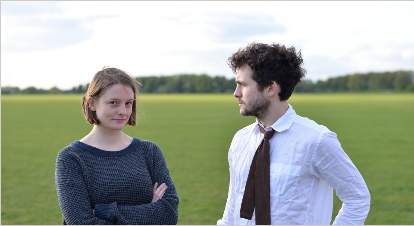Another Timbre TimHarrisonbre

at177 Barbara Monk Feldman ‘Verses’
performed by the GBSR Duo with Mira Benjamin
1. Duo for Piano and Percussion (1988) 14:14
Siwan Rhys (piano) George Barton (percussion)
2. Verses for Vibraphone (1994) 4:45
George Barton (percussion)
3. The I and Thou (1988) 16:50 youtube extract 1
Siwan Rhys (piano)
4. The Northern Shore (1997) 31:03 youtube extract 2
Siwan Rhys (piano) George Barton (percussion) Mira Benjamin (violin)
5. Clear Edge (1993) 4:55
Siwan Rhys (piano)
Interview with Barbara Monk Feldman, by Siwan Rhys & George Barton
In the past you've written that “decay in the piano and vibraphone brings them closer to the background ‘wall’ of silence…. Sound and silence become attached to each other not unlike sculptural figures attached to a wall”. Can you say a little about the relationship of sound and silence in your piano and percussion music?
I have been thinking about what is inside and what is outside. The everyday life and tragedy of what goes on around you, and the fact that to accomplish anything you need the isolation in the studio - I think about this moral issue. And then on another level, I think about an inside and an outside for art itself, and how ephemeral that is. For example, an unexpected moment in the sculpture of Giacometti, where it’s as though you suddenly have a brief glimpse into infinity. Or where in Cézanne you have an equally unpredictable experience in a fleeting recognition of something transient in the landscape. These moments are like a kind of recognition – and ironically, they include something that seems to come to us from the inside.
Can you tell us a little about the titles of the pieces on the disc? What does The Northern Shore refer to, for example?
The title for The Northern Shore comes from the place I visit every summer in the Gaspé peninsula in eastern Quebec where the St. Lawrence river meets the Atlantic ocean. Nature is a complex inspiration. I see a kind of gravity in the light at horizons near the ocean, and watch how it affects the movement of light and reflect on it. I ask myself whether the reflections I have or the other things I notice in nature can enter into the music unawares?
One striking feature of your notation in many of the pieces on the disc is the frequent occurrence of grace notes being used to frame silences. Can you tell us about your preference for this notation?
What I am looking for is a way to notate the most intangible aspect of the music – for me that is the colour. Colour is not only the instrumentation. It also involves the ‘weight’ of the tones, and a kind of gravity in the relationship of the sound and silence, as well as the spacing of duration and registration.
The aspects of colour are the most difficult to notate. They are unlike the notes and the rhythm, which are easier to contain and to notate, and are easier to measure. But colour remains more mysterious to me. Where does the colour of one sound really end, if you see what I mean? And what happens in the overlap of one colour with others?
What fascinates me is how much the color resists being measured, or, if you will, notated. There isn’t a ‘right’ way or ‘wrong’ way, and yet somehow, you go by a sense of when you arrive at something or when you find a place where you can just leave it alone. Some very small thing suddenly feels right, and you try not to think about it and move on. I have always felt music composing is about bringing body back into mind. There is a mystical side of Wittgenstein, who said when we look into the sky our eye brushes against infinity.
You mentioned to us recently that you are interested in Noh Theatre at the moment. Is this feeding into a musical project? Can you describe some of the projects you’ve been working on in recent years?
In recent years I have been much preoccupied with two operas -the second one I finished just before the pandemic began. I think of them as ‘non-operas’ because they are not involved with drama in the traditional manner. In composing the operas I already felt drawn to Noh theatre in the sense that there is little or no action. In the operas there is a focus on sustaining a musical image as a ‘background’ - something I can’t clearly define: it involves a sense of the musical imagery hovering in one place, as it were, attended by a fluidity in the slow transitioning of the harmonic color.
In current projects following the operas I am wondering if it is possible to write a music version for ‘haiku’ or of ‘haibun’? I want to learn about the haiku and Noh theatre as much as I can.
Along with this I have also been thinking about the spiritual aspect of music. Which gets back to the question of inside and outside. What could be more spiritual than intimating some kind of connection between inner and outer?
It is very difficult to talk about one’s work. I am anxious to stop before I start believing too much in what I say! As I was thinking over these questions you sent me in the past days I made the following attempt at writing a haiku. Maybe it is a good place to leave off.
thoughts without words music falling
river flows by

Barbara Monk Feldman (photo: Canadian Opera Company)

GBSR Duo (photo: Dejan Mrdja)